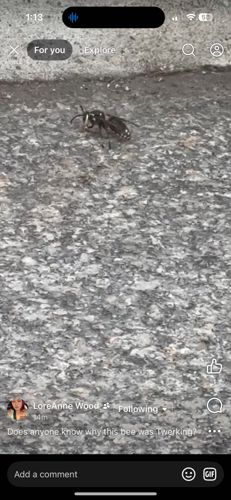Cuckoo Bee
Scientific Name: Nomada spp. (likely)
Order & Family: Hymenoptera, Apidae
Size: Typically 5-15 mm (0.2-0.6 inches)

Natural Habitat
Found in various habitats where host bees (typically Andrena, Lasioglossum, or Eucera species) are present, including meadows, woodlands, gardens, and urban areas.
Diet & Feeding
Adult cuckoo bees feed on nectar. Their larvae, however, are kleptoparasites, feeding on pollen and nectar provisions gathered by their host bees.
Behavior Patterns
Cuckoo bees are solitary, cleptoparasitic bees. Females do not build their own nests or provision for their young. Instead, they enter the nests of other bee species (their hosts) and lay their eggs. The cuckoo bee larva then consumes the host larva's food supply, often after killing the host larva or egg. The 'twerking' behavior mentioned in the image caption could refer to a female bee searching for a host nest, or potentially attempting to enter a nest.
Risks & Benefits
Cuckoo bees pose no direct risk to humans as they are not aggressive and rarely sting. They do not contribute to pollination in the same way as other bees because they do not collect pollen. While their kleptoparasitic lifestyle can impact host bee populations, they are a natural part of the ecosystem and reflect the biodiversity of bee species. They can serve as an indicator of the presence of their host bee species.
Identified on: 9/17/2025